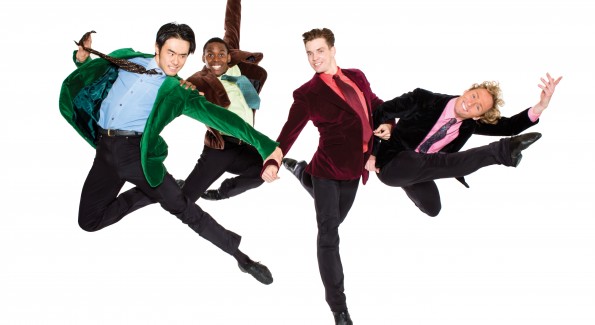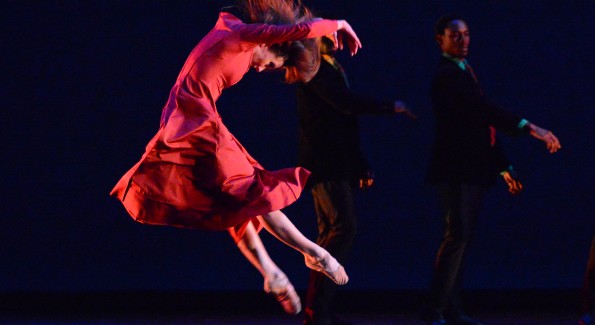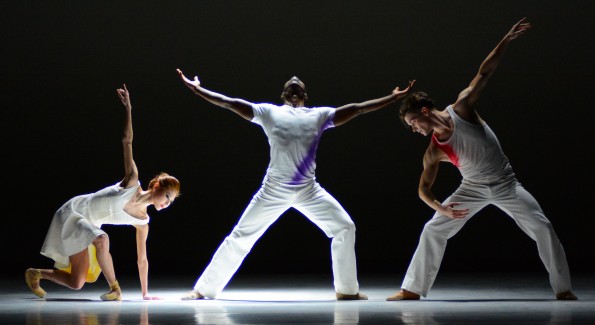The dance company’s latest performance interprets the music of rock’s most influential groups.
By Kelly A. Magyarics

Chong Sun, Andile Ndlovu, Jonathan Jordan and Jared Nelson in ‘British Invasion.’ (Photo by Tony Brown)
How best to tackle onstage the music of arguably the two most famous rock bands of all time? (Die-hard fans can argue among themselves which of the two deserves the title of “best band of all time.”) There is certainly no shortage of cover bands and impressionists out there promising to deliver an authentic Beatles or Rolling Stones experience. But don’t expect to see mop tops, pointy boots, Nehru jackets or Sgt. Pepper uniforms at The Kennedy Center this weekend. The two rock ballets in the three-act “British Invasion: The Beatles & The Rolling Stones,” led by Artistic Director Septime Webre, are highly interpretative, rather than caricature or spectacle, evoking the themes put forth by rock’s best song writers in a way that’s powerful yet understated.
The Washington Ballet first presented Christopher Bruce’s rock ballet “Rooster” in 2011, which is named for and starts with Willie Dixon’s blues classic “Little Red Rooster,” recorded by The Rolling Stones in 1964. Here, said roosters are swaggering, cocky men, strutting around the stage and thrusting out their chins mimicking the title character. Marian Bruce’s costumes give a nod to the era, with the men in trousers and velvet jackets in various colors, and the women in sleeveless black dresses whose pleats reveal a splash of bright (“I see a black dress and I want it, paint it red.”)
The company tackles eight of the Stones songs in the evening’s first act, which is at times playful, thoughtful and melancholic. Jared Nelson and Francesca Dugarte shine in the crisp choreography of the opening sequence, as the men try to establish their alpha male dominance, and the ladies provide them with the first of many comeuppances. In “As Tears Go By,” several members of the ensemble are excluded by the rest of the group, kept outside the circle like children on a playground (“Smiling faces I can see, but not for me, I sit and watch, as tears go by.”)
Two of the company’s top ballerinas get their moments. Sona Kharatian is flirty, sensual and playful as the much desired Lady Jane, courted by Brooklyn Mack in a lovely pas de deux. Morgann Rose is fitting as the ever-changing, free-spirited, she-comes-and-goes Ruby Tuesday (“Who could hang a name on you?”). Her fluid, ethereal movements match her flowing ruby-hued gown.

Morgann Rose as Ruby Tuesday. (Photo by Paul Wegner)
“Rooster” ends with the Stones’ classic narcissistic tale of Lucifer himself. The intro’s percussion, punctuated by Mick Jagger’s primal screams, sets off Bruce’s choreography for “Sympathy for the Devil.” The choreography is powerful, strong and energetic, as the audience ponders the reason for all the evil in the world, summed up by Jagger’s personal philosophy “Just as every cop is a criminal, and all the sinners saints.”
Originally presented by the Washington Ballet in 2006, Trey McIntyre’s “A Day in the Life” was then called “Always, No Sometimes.” The songs in this third act focus on the latter part of the Beatles’ rich career, when they traded the poppy, simple lyrics and melodies of ditties like “She Loves You” for songs with decidedly more depth and introspection, like “Across the Universe” and “Eleanor Rigby.” Five of the 12 songs in “A Day in the Life” are taken from the White Album, including the experimental “Wild Honey Pie,” whose omission from the program was either an oversight, or designed to seek out true Beatles fanatics. Costumes designed by Bisou Consortium reflect that influence, with performers dressed in all white, save for a bright stripe of spray paint somewhere on their attire. The set’s white background also references the stark, simple cover of the group’s two-disc masterpiece.
The act begins with “Mother Nature’s Son,” with the ensemble forming a circle around Brooklyn Mack, who breaks away in his solo to show a struggle to maintain his body’s synergy. Other solo performances in the piece are standouts. Jonathan Jordan’s movements in the aforementioned “Wild Honey Pie” are frenetic and herky jerky, akin to the song’s experimental, avant-garde musical arrangement. Likewise, in “Julia,” Lennon’s touching tribute to his mother who was struck and killed by a car when he was just 18, Maki Onuki moves in a mechanical, awkward, flat-footed manner which speaks to the impact that his mother’s death had on Lennon, his life and his music.

Maki Onuki, Brooklyn Mack and Jonathan Jordan. (Photo by Paul Wegner)
But it’s not all melancholy. Many of the ensemble pieces are great fun, especially for Beatles fans with a deep knowledge of the group’s entire catalog, not to mention Beatles trivia. The choreography of “The Ballad of John and Yoko,” in which Lennon recounts his struggles with the media to live a normal life (“The newspapers said, ‘She’s gone to his head, they look just like two gurus in drag’”), is — like Lennon was — spirited and a bit irreverent. “Got to Get You Into My Life” is rousing and bright (and without a “wink wink” reference to the subject about which McCartney extols the virtues — look it up.) The sing-along-if-you-know-it “Ob-La-Di, Ob-La-Da” is a well-synchronized pleasure for the eyes, not to mention an irresistible joy to listen to.
The act — and the show — ends with the namesake masterpiece from the Sgt. Pepper album in which the songwriting duo trade verses and themes. Lennon’s more weighty contemporary news items (“He blew his mind out in a car”) contrast with McCartney’s more innocent, mundane details of daily life (“Woke up, fell out of bed, dragged a comb across my head.”) The ensemble mirrors the sense of anxiety and discord displayed by Brooklyn Mack in the beginning of the act, until the song culminates in the orchestral cacophony, followed by that sustained piano note. It’s worth mentioning that the sound in the Kennedy Center for this performance was rich and vibrant. All the songs sounded true to life and at times felt almost as if Lennon or McCartney were onstage singing.
Sandwiched between the so-called battle of the bands in the second act is “There Where She Loved,” originally performed by the company in 2005. Choreographed by Christopher Wheeldon, with music by Frederic Chopin and Kurt Weill, the piece mixes classical ballet with modern movements. Through its seven songs — which aren’t narratively linked but work together in theme — the ballet tells the story of romantic relationships in different stages of ebb and flow. Soprano CarrieAnne Winter and mezzo soprano Shelley Waite flank the stage, trading songs of romance, unrequited love, bitterness, loss and farewells, accompanied by Glenn Sales on piano. In cool jewel tones designed by Holly Hynes, the company evokes love in all its moods. Audience members who expected a rocking, rollicking good time throughout the evening may have found the second act lost momentum. Perhaps love is not all you need, as this piece may have had more room to shine in the context of a different show.
“British Invasion” continues through March 9, 2014, at the Kennedy Center. Tickets from $35 to $125 available at 202-467-4600 or online here.
Kelly Magyarics is a freelance writer in the Washington, D.C. area. She can be reached through her website, www.kellymagyarics.com, or on Twitter and Instagram @kmagyarics.
